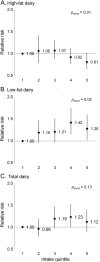Intake of dairy foods and risk of Parkinson disease
- PMID: 28596209
- PMCID: PMC5496517
- DOI: 10.1212/WNL.0000000000004057
Intake of dairy foods and risk of Parkinson disease
Abstract
Objective: To prospectively examine the association between commonly consumed dairy products and the risk of Parkinson disease (PD) in women and men.
Methods: Analyses were based on data from 2 large prospective cohort studies, the Nurses' Health Study (n = 80,736) and the Health Professionals Follow-up Study (n = 48,610), with a total of 26 and 24 years of follow-up, respectively. Both US-based studies were conducted via mailed biennial questionnaires. Dietary intake was assessed with food frequency questionnaires administered repeatedly over the follow-up period. Incident cases of PD (n = 1,036) were identified via questionnaires and subsequently confirmed by reviewing medical records. We also conducted a meta-analysis to combine our study with 3 previously published prospective studies on total milk intake and PD risk and 1 study on total dairy intake and PD risk.
Results: While total dairy intake was not significantly associated with PD risk in our cohorts, intake of low-fat dairy foods was associated with PD risk. The pooled, multivariable-adjusted hazard ratio (HR) comparing people who consumed at least 3 servings of low-fat dairy per day to those who consumed none was 1.34 (95% confidence interval [CI] 1.01-1.79, p trend = 0.04). This association appeared to be driven by an increased risk of PD associated with skim and low-fat milk (HR 1.39, 95% CI 1.12-1.73, p trend <0.01). Results were similar in women and men (p for heterogeneity >0.05). In the meta-analysis, the pooled relative risk comparing extreme categories of total milk intake was 1.56 (95% CI 1.30-1.88), and the association between total dairy and PD became significant (HR 1.27, 95% CI 1.04-1.55).
Conclusions: Frequent consumption of dairy products appears to be associated with a modest increased risk of PD in women and men.
© 2017 American Academy of Neurology.
Figures


Similar articles
-
Associations of dairy intake with risk of mortality in women and men: three prospective cohort studies.BMJ. 2019 Nov 27;367:l6204. doi: 10.1136/bmj.l6204. BMJ. 2019. PMID: 31776125 Free PMC article.
-
Consumption of milk and other dairy products and incidence of Parkinson's disease: a prospective cohort study in French women.Eur J Epidemiol. 2024 Sep;39(9):1023-1036. doi: 10.1007/s10654-024-01152-2. Epub 2024 Sep 18. Eur J Epidemiol. 2024. PMID: 39294525
-
Diet and Parkinson's disease: a potential role of dairy products in men.Ann Neurol. 2002 Dec;52(6):793-801. doi: 10.1002/ana.10381. Ann Neurol. 2002. PMID: 12447934
-
Consumption of dairy product and its association with total and cause specific mortality - A population-based cohort study and meta-analysis.Clin Nutr. 2019 Dec;38(6):2833-2845. doi: 10.1016/j.clnu.2018.12.015. Epub 2018 Dec 18. Clin Nutr. 2019. PMID: 30595374
-
Dairy products intake and cancer mortality risk: a meta-analysis of 11 population-based cohort studies.Nutr J. 2016 Oct 21;15(1):91. doi: 10.1186/s12937-016-0210-9. Nutr J. 2016. PMID: 27765039 Free PMC article. Review.
Cited by
-
The Impact of Environmental Factors on Monogenic Mendelian Diseases.Toxicol Sci. 2021 Apr 27;181(1):3-12. doi: 10.1093/toxsci/kfab022. Toxicol Sci. 2021. PMID: 33677604 Free PMC article.
-
Nicotine promotes neuron survival and partially protects from Parkinson's disease by suppressing SIRT6.Acta Neuropathol Commun. 2018 Nov 8;6(1):120. doi: 10.1186/s40478-018-0625-y. Acta Neuropathol Commun. 2018. PMID: 30409187 Free PMC article.
-
Diet Quality and Risk of Parkinson's Disease: The Rotterdam Study.Nutrients. 2021 Nov 7;13(11):3970. doi: 10.3390/nu13113970. Nutrients. 2021. PMID: 34836224 Free PMC article.
-
Milk consumption and multiple health outcomes: umbrella review of systematic reviews and meta-analyses in humans.Nutr Metab (Lond). 2021 Jan 7;18(1):7. doi: 10.1186/s12986-020-00527-y. Nutr Metab (Lond). 2021. PMID: 33413488 Free PMC article. Review.
-
Synergistic Effects of Milk-Derived Exosomes and Galactose on α-Synuclein Pathology in Parkinson's Disease and Type 2 Diabetes Mellitus.Int J Mol Sci. 2021 Jan 21;22(3):1059. doi: 10.3390/ijms22031059. Int J Mol Sci. 2021. PMID: 33494388 Free PMC article. Review.
References
-
- Chen H, Zhang SM, Hernan MA, Willett WC, Ascherio A. Diet and Parkinson's disease: a potential role of dairy products in men. Ann Neurol 2002;52:793–801. - PubMed
-
- Park M, Ross GW, Petrovitch H, et al. . Consumption of milk and calcium in midlife and the future risk of Parkinson disease. Neurology 2005;64:1047–1051. - PubMed
-
- Saaksjarvi K, Knekt P, Lundqvist A, et al. . A cohort study on diet and the risk of Parkinson's disease: the role of food groups and diet quality. Br J Nutr 2013;109:329–337. - PubMed
-
- Kyrozis A, Ghika A, Stathopoulos P, Vassilopoulos D, Trichopoulos D, Trichopoulou A. Dietary and lifestyle variables in relation to incidence of Parkinson's disease in Greece. Eur J Epidemiol 2013;28:67–77. - PubMed
MeSH terms
Grants and funding
LinkOut - more resources
Full Text Sources
Other Literature Sources
Medical
